

Tumulus. The Royal mounds of Gamla Uppsala in Sweden from the 5th and the 6th centuries.
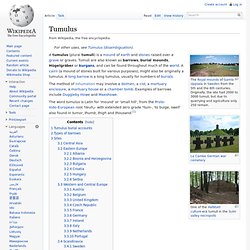
Originally, the site had 2000 to 3000 tumuli, but due to quarrying and agriculture only 250 remain. The method of inhumation may involve a dolmen, a cist, a mortuary enclosure, a mortuary house or a chamber tomb. Examples of barrows include Duggleby Howe and Maeshowe. The word tumulus is Latin for 'mound' or 'small hill', from the Proto-Indo-European root *teuh2- with extended zero grade *tum-, 'to bulge, swell' also found in tumor, thumb, thigh and thousand.[1] Tumulus burial accounts[edit] Black Rock Gorge. The Black Rock Gorge, on the Allt Graad, viewed from the top.
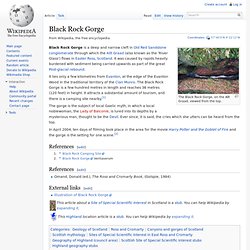
It lies only a few kilometres from Evanton, at the edge of the Evanton Wood in the traditional territory of the Clan Munro. The Black Rock Gorge is a few hundred metres in length and reaches 36 metres (120 feet) in height. Chanonry of Ross. Construction[edit] 16th century siege[edit]
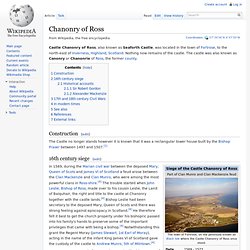
Kukherd. Kukherd (Persian: كوخرد, also Romanized as Kūkherd, Kookherd, and Kuhkhird; also known as Chāleh Kūkherd)[1] is a city in and the capital of Kukherd District, in Bastak County, Hormozgan Province, Iran.

At the 2006 census, its population was 3,144, in 637 families.[2] Location and geography[edit] Old building in Kukherd Kukherd is a district (Bakhsh بخش) located on the south western side of Iran in the Hormozgān Province, 155 kilometers south of the city of Lar and 45 kilometers from the city of Bastak. The Mehran river flows through its northern parts. A chain of mountains extends about 55 kilometers from east to west in northern parts of Kukherd forming a natural barrier that separates Koohkerd from other villages.
Demography and ethnicity[edit]
Other. Babylon. Loch Langavat. Benbecula. Benbecula (/bɛnˈbɛkjʉlə/; Scottish Gaelic: Beinn nam Fadhla,[6] pronounced [peɲəˈvɤːlˠ̪ə]) is an island of the Outer Hebrides in the Atlantic Ocean off the west coast of Scotland.
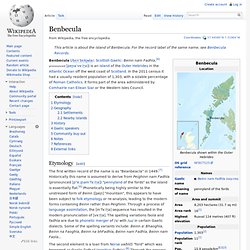
In the 2011 census it had a usually resident population of 1,303, with a sizable percentage of Roman Catholics. It forms part of the area administered by Comhairle nan Eilean Siar or the Western Isles Council. Eriskay. Eriskay (Scottish Gaelic: Èirisgeigh, pronounced [ˈeɾʲiʃkʲej]), from the Old Norse for "Eric's Isle", is an island and community council area of the Outer Hebrides in northern Scotland.
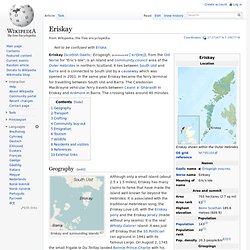
It lies between South Uist and Barra and is connected to South Uist by a causeway which was opened in 2001. In the same year Eriskay became the ferry terminal for travelling between South Uist and Barra. The Caledonian MacBrayne vehicular ferry travels between Ceann a' Ghàraidh in Eriskay and Ardmore in Barra. The crossing takes around 40 minutes. Butt of Lewis. Lake monster. A lake monster or loch monster is a purported form of fresh-water-dwelling megafauna appearing in mythology, rumor, or local folklore, but whose existence lacks scientific support.
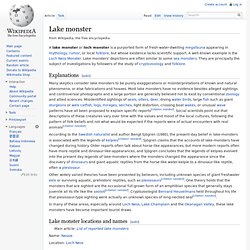
A well-known example is the Loch Ness Monster. Lake monsters' depictions are often similar to some sea monsters. They are principally the subject of investigations by followers of the study of cryptozoology and folklore. Explanations[edit] Many skeptics consider lake monsters to be purely exaggerations or misinterpretations of known and natural phenomena, or else fabrications and hoaxes. According to the Swedish naturalist and author Bengt Sjögren (1980), the present-day belief in lake-monsters is associated with the legends of kelpies[citation needed]. Other widely varied theories have been presented by believers, including unknown species of giant freshwater eels or surviving aquatic, prehistoric reptiles, such as plesiosaurs[citation needed].
Lake monster locations and names[edit] Name: Nessie. Cliffs of Moher. Coordinates: Looking north towards O'Brien's Tower Name[edit] Nineteenth-century view of the cliffs and Leacmayornagneeve rock in the foreground The cliffs take their name from an old fort called Moher that once stood on Hag's Head, the southernmost point of the cliffs.
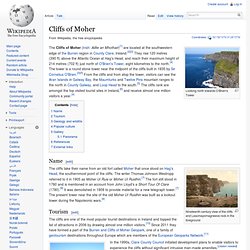
The writer Thomas Johnson Westropp referred to it in 1905 as Moher Uí Ruis or Moher Uí Ruidhin.[7] The fort still stood in 1780 and is mentioned in an account from John Lloyd's a Short Tour Of Clare (1780).[8] It was demolished in 1808 to provide material for a new telegraph tower.[7] The present tower near the site of the old Moher Uí Ruidhin was built as a lookout tower during the Napoleonic wars.[9] Tourism[edit] Visitor centre In the 1990s, Clare County Council initiated development plans to enable visitors to experience the cliffs without significant intrusive man-made amenities. The €32 million facility was planned and built over a 17-year period, and officially opened in February 2007. Isle of Man. The Isle of Man (/ˈmæn/; Manx: Ellan Vannin [ˈɛlʲən ˈvanɪn][4]), otherwise known simply as Mann (Manx: Mannin, IPA: [ˈmanɪn]), is a self-governing British Crown Dependency, located in the Irish Sea between the islands of Great Britain and Ireland.
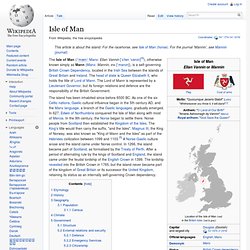
River Ness. The River Ness (Scottish Gaelic: Abhainn Nis) is a river about 12 miles or 20 km long, which flows from the northern end of Loch Ness in Scotland, through Loch Dochfour,[1] north-east to Inverness, with a total fall in height of about 16 metres before discharging into the Beauly Firth.
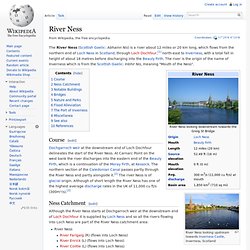
Gulf of Corryvreckan. The Gulf of Corryvreckan (from the Gaelic Coire Bhreacain meaning "cauldron of the speckled seas" or "cauldron of the plaid"), also called the Strait of Corryvreckan, is a narrow strait between the islands of Jura and Scarba, in Argyll and Bute, off the west coast of mainland Scotland. It is possible for tourists to visit the site by way of boat trips from local harbours. Topography[edit] Cheshire. Cheshire's area is 2,343 square kilometres (905 sq mi) and its population is around 1 million. Apart from the large towns along the River Mersey and the historic city of Chester, it is mostly rural, with a number of small towns and villages that support an agricultural industry. It is historically famous as a former principality and for the production of Cheshire cheese,[4] salt, bulk chemicals, and woven silk.
History[edit] Toponymy[edit] Because of the historically close links with the land bordering Cheshire to the west, which became modern Wales, there is a history of interaction between Cheshire and North Wales. Administrative history[edit] Ben Nevis. The mountain is a popular destination, attracting an estimated 100,000 ascents a year,[2] around three-quarters of which use the Pony Track from Glen Nevis.[3] The 700-metre (2,300 ft) cliffs of the north face are among the highest in the United Kingdom, providing classic scrambles and rock climbs of all difficulties for climbers and mountaineers. They are also the principal locations in the UK for ice climbing.
The summit, which is the collapsed dome of an ancient volcano,[4] features the ruins of an observatory which was continuously staffed between 1883 and 1904. The meteorological data collected during this period are still important for understanding Scottish mountain weather. C. T. Loch Ness. Loch Ness Loch Ness (/ˌlɒx ˈnɛs/; Scottish Gaelic: Loch Nis, [l̪ˠɔxˈniʃ]) is a large, deep, freshwater loch in the Scottish Highlands extending for approximately 37 km (23 mi) southwest of Inverness.
Its surface is 15.8 m (52 ft) above sea level. Rocabarraigh. Cairngorms. Lochmaben Stone. Evanton. Coordinates: Clan Mackenzie. Clan Mackenzie is a Highland Scottish clan, traditionally associated with Kintail and lands in Ross-shire. Sandwick, Shetland. See also Sandwick, Whalsay and Sandwick, Orkney. Harris, Scotland. Coordinates: South Uist. Clan Cameron. Clan Cameron is a West Highland Scottish clan, with one main branch Lochiel, and numerous cadet branches.
Inverness. Phantom island. Evanton. Teaninich Castle. Balconie Castle. Novar House. Dingwall (name) Ben Macdui. Rockall. Lemlair House. Contullich Castle. Foulis Castle. Lemlair House. Milntown Castle. Newmore Castle.
Scotland.